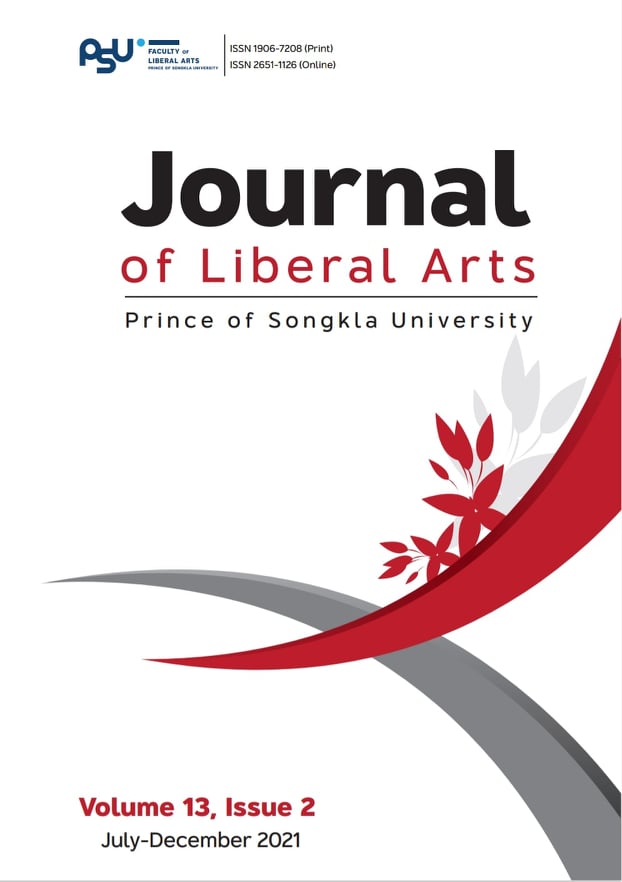The Effects of Cultural Familiarity on Reading Comprehension and Attitudes Towards Reading English Short Stories Written by a Native Speaker and a Thai Author
DOI: 10.14456/jlapsu.2021.6
Keywords:
cultural familiarity, cultural schema, reading comprehension, English literature, local literature in EnglishAbstract
Literature is an integral part of language learning. Literary works written
by native speakers are the predominant reading materials for English-
major students in Thai universities while Thai literature written in English
is often overlooked. Based on the hypothesis that reading comprehension
of literary works requires cultural familiarity, this article reports on a quasi
-experimental study assessing the impact of cultural familiarity on reading
comprehension. In addition, this study also aimed to explore Thai English-
major students’ attitudes towards reading English short stories. Participants
of this study were thirty-five English-major students taking English literature
courses at the Faculty of Liberal Arts, Prince of Songkla University. The
instruments were (1) two short stories with a comparable theme, linguistic
complexity and length but in different cultural contexts – one in an American
and the other in a Thai context, (2) a reading comprehension test from the
two texts, and (3) a questionnaire on the participants’ attitudes towards
reading the two texts. The findings showed that the culturally familiar
text resulted in significantly better literal, inferential and overall
comprehension. In addition, participants found that the Thai short
story surpassed the American short story in the aspects of authenticity,
ease of understanding and interest. Implications for selection of reading
materials are discussed.
References
Abu-Rabia, S. (1999). Towards a second-language model of learning in problematic social contexts: The case of Arabs learning Hebrew in Israel. Race Ethnicity and Education, 2(1), 109-126.
Alptekin, C. (1993). Target-language culture in EFL materials. ELT Journal, 47(2), 136-143.
Alptekin, C. (1996). Target-language culture in EFL materials. In T. Hedge & N. Whitney (Eds.), Power, pedagogy and practice (pp. 53-61). Oxford University Press.
Alptekin, C. (2006). Cultural familiarity in inferential and literal comprehension in L2 reading. System, 34(4), 494–508.
Alptekin, C., & Alptekin, M. (1984). The question of culture: EFL teaching in non-English-speaking countries. ELT Journal, 38(1), 14-20.
Bartlett, F. C., & Burt, C. (1933). Remembering: A study in experimental and social psychology. British Journal of Educational Psychology, 3(2), 187-192.
Carrell, P. L. (1983). Schema theory and ESL reading pedagogy. TESOL Quarterly, 17(4), 553-573.
Carrell, P. L. (1987). Content and formal schemata in ESL reading. TESOL Quarterly, 21(3), 461-481.
Chan, C. (n.d.). Assessment: Short answer questions. https://ar.cetl.hku.hk/am_saq.htm
Chihara, T., Sakurai, T., & Oller, J. W. (1989). Background and culture as factors in EFL reading comprehension. Language Testing, 6(2), 143-149.
Clark, M. S., & Fiske, S. T. (2014). Affect and Cognition: 17th Annual Carnegie Mellon Symposium on Cognition. Taylor&Francis.https://books.google.co.th/books?id=-ciYAgAAQBAJ
Elizabeth, R. G. (1980). On cultural schemata. American Ethnologist, 7(1), 152-171.
Erten, I. H., & Razi, S. (2009). The effects of cultural familiarity on reading comprehension. Reading in a Foreign Language, 21(1), 60-77.
Ghosn, I. K. (2002). Four good reasons to use literature in primary school ELT. ELT Journal, 56(2), 172-179.
Hismanoglu, M. (2005). Teaching English through literature. Journal of Language and Linguistic Studies, 1(1), 53-56.
Jalilifar, A. R., & Assi, R. (2008). The role of cultural nativization in comprehension of short stories in EFL reading contexts. The International Journal of Language Society and Culture, 26, 62-79.
Johnson, P. (1981). Effects on reading comprehension of language complexity and cultural background of a text. TESOL Quarterly, 15(2), 169-181.
Ketchum, E. M. (2006). The cultural baggage of second language reading: An approach to understanding the practices and perspectives of a nonnative product. Foreign Language Annals, 39(1), 22-42.
Larsen, S. F. & Laszlo, J. (1990). Cultural-historical knowledge and personal experience in appreciation of literature. European Journal of Social Psychology, 20, 425-440.
Lazarus, R. S. (1982). Thoughts on the relations between emotion and cognition. American Psychologist, 37(9), 1019-1024.
McCarthy, K. S., & Goldman, S. R. (2015). Comprehension of short stories: Effects of task instructions on literary interpretation. Discourse Processes, 52(7), 585-608.
Madeeyoh, C. & Charumanee, N. (2013). The use of Islamic context texts to improve Muslim students’ English reading skills. Journal of Liberal Arts, Prince of Songkla University, 5(2), 47-58.
Mahoney, D. (1991). Asian voices in English: Asian-English literature in the ESL curriculum. Perspectives: Working Papers of the Department of English at City Polytechnic of Hong Kong, 3(1), 79-88.
Mart, C. T. (2018). Literature in the language classroom: A recipe to maximize learning. L1-Educational Studies in Language and Literature, 18, 1-25.
Matsumoto, D. (2009). The Cambridge dictionary of psychology. Cambridge University Press.
Nostrand, H. L. (1989). Authentic texts and cultural authenticity: An editorial. The Modern Language Journal, 73(1), 49-52.
Pearson, D. P., Johnson, D. (1978). Teaching reading comprehension. Holt, Rinehart, and Winston.
Phillips, J. L. (1969). The origins of intellect: Piaget's theory. W. H. Freeman.
Reynolds, R. E., Taylor, M. A., Steffensen, M. S., Shirey, L. L. & Anderson, R.C.(1982).Cultural schemata and reading comprehension. Reading Research Quarterly, 17(3), 353-366.
Shrestha, P. N. (2008). Using stories with young learners. In M. Krzanowski (Ed.), Current developments in English for academic, specific and occupational purposes. Garnet publishing.
Snow, C. (2002). Reading for understanding: Toward a research and development program in reading comprehension. Rand Corporation. https://www.rand.org/pubs/monograph _reports/MR1465.html
Steffensen, M. S., Joag-Dev, C., & Anderson, R. C. (1979). A cross cultural perspective on reading comprehension. Reading Research Quarterly, 15(1), 10-29.
Sudham, P. (2004). It is the people of Thailand and other countries. Shire Books.
Tavakoli, M., Shirinbakhsh, S., & Rezazadeh, M. (2013). Effect of cultural adaptation on EFL reading comprehension: The role of narrative nativization and foreign language attitude. World Applied Sciences Journal, 21, 1587-1596.
Tucker, B. J. (2014). On a darkling plain: Stories from the great depression. Livingston Press.
Zajonc, R. B. (1984). On the primacy of affect. American Psychologist, 39(2), 117-123.
Downloads
Published
How to Cite
Issue
Section
License
The authors retain the copyright to their article but the Journal of Liberal Arts, Prince of Songkla University reserves the exclusive rights to first publication.






